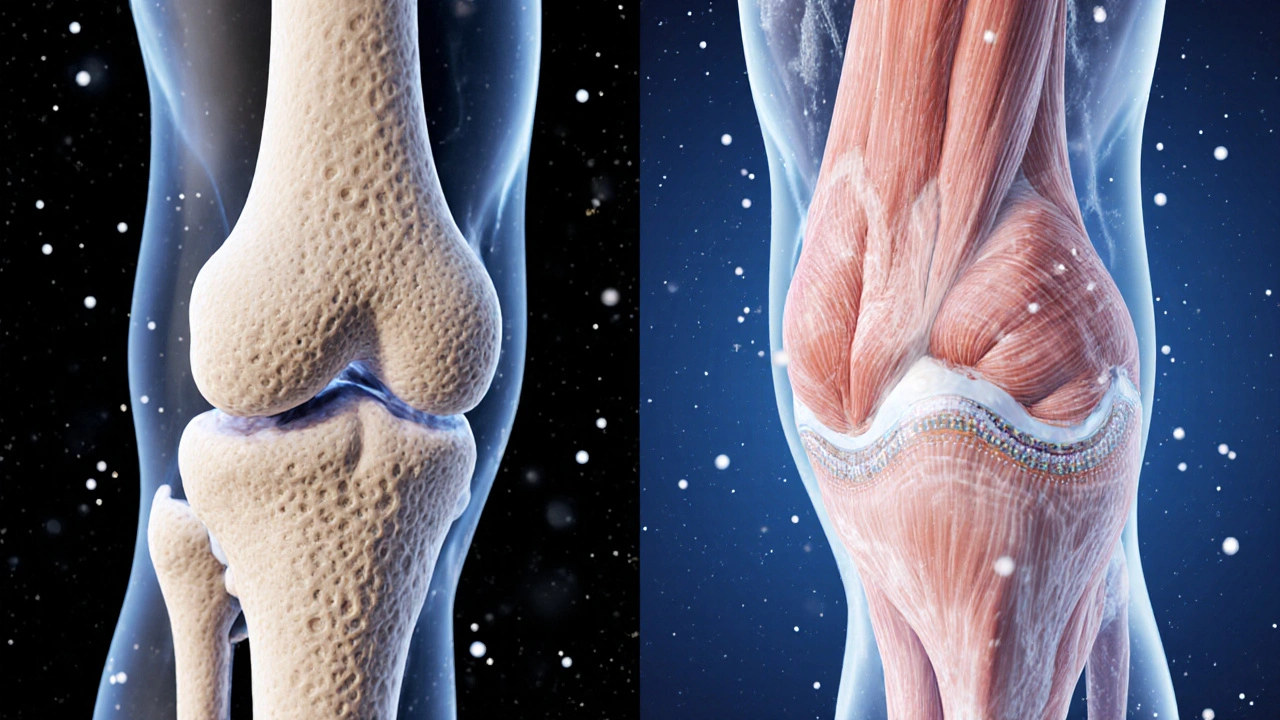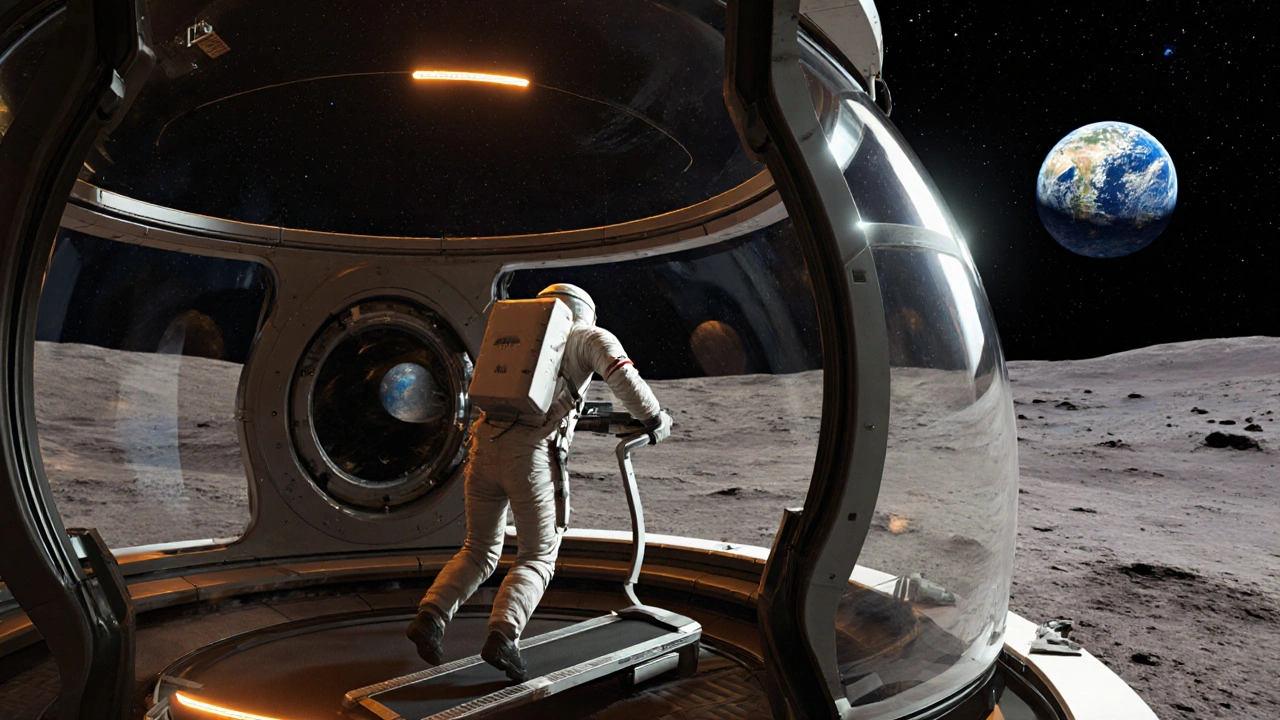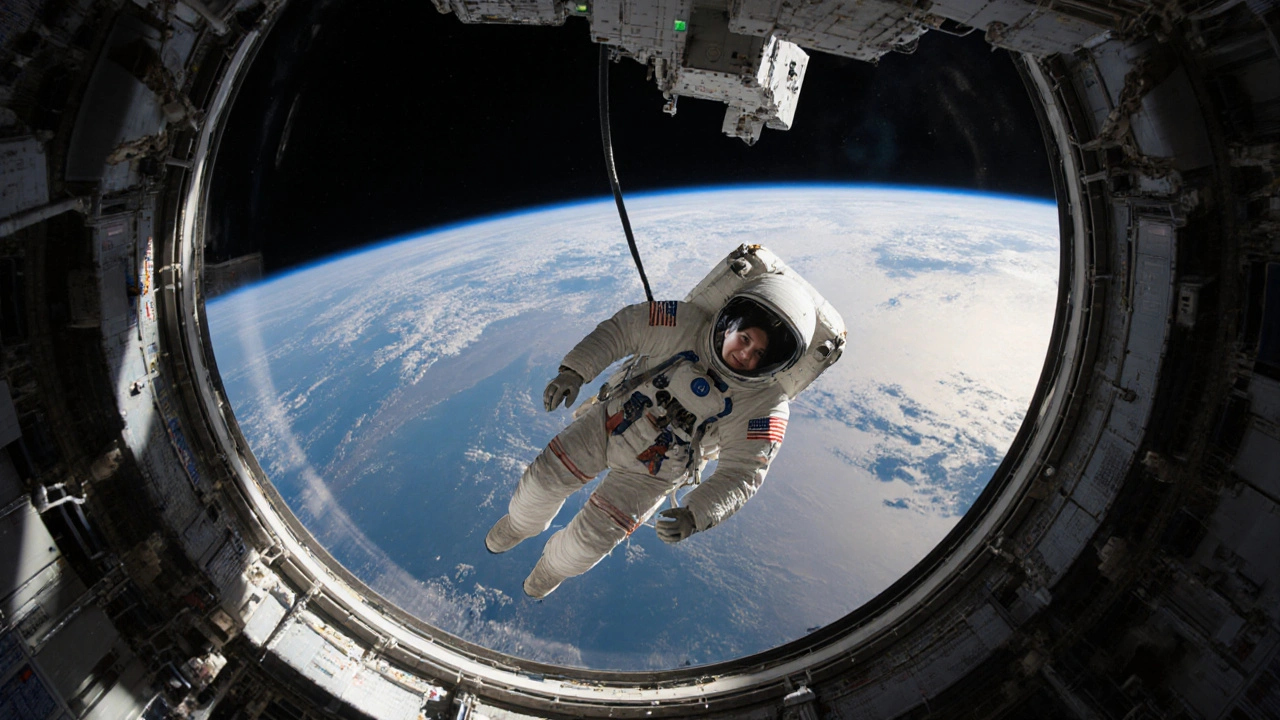Astronaut Bone Density Loss Calculator
Bone density decreases at a rate of 1-2% per month in microgravity. This calculator estimates how much bone density an astronaut might lose during a space mission based on duration.
Ever wonder why a short trip to space feels like a workout for the whole body? When a Astronaut is a trained human who lives and works in the microgravity environment of orbit, their body goes through changes that would surprise anyone who’s spent most of their life on Earth. Below we break down the biggest physiological surprises, why they matter, and how agencies are fighting back.
Microgravity: The Core Trigger
In orbit, gravity isn’t gone-it’s just about 90% weaker than on the surface. That condition is called Microgravity the state of near‑weightlessness that causes fluids, bones, and muscles to behave differently. Without the constant pull, the body receives mixed signals: it thinks it’s still standing upright, yet the skeleton isn’t bearing load. Those mixed signals start a cascade of changes that affect almost every system.
Bone Density - The Silent Shrink
Bone is a living tissue that remodels itself in response to stress. On Earth, the 2g of force we experience daily keeps bones strong. In space, that stress drops dramatically, and Bone Density measures the amount of mineral content packed into bone tissue can fall 1-2% each month. A typical six‑month ISS mission might shave off the equivalent of a year’s worth of bone loss for a sedentary adult.
Muscle Atrophy - Weaker Than Ever
Muscles need resistance to stay thick. In microgravity, the leg and back muscles that normally fight gravity get almost no work, leading to Muscle Atrophy the reduction in muscle mass and strength caused by disuse. Astronauts can lose up to 20% of their quadriceps strength after a few weeks. That’s why daily exercise on a treadmill with harnesses, a stationary bike, and a resistance device is mandatory on the ISS.
Space Radiation - An Invisible Hazard
Outside Earth’s magnetic shield, high‑energy particles zip through space. Space Radiation consists of galactic cosmic rays and solar particle events that can damage DNA and cells is a long‑term health risk. While short missions see minimal acute effects, cumulative exposure raises concerns about cancer, cataracts, and cardiovascular disease later in life.
Vision Changes - The SANS Phenomenon
One of the more mysterious side‑effects is Spaceflight‑Associated Neuro‑ocular Syndrome (SANS). Fluid shifts toward the head in microgravity increase pressure on the eyes, leading to flattened eyeballs, optic disc swelling, and blurry vision. About a third of long‑duration crewmembers report some visual degradation, which can linger after return.

Immune System - A Slower Response
The immune system also feels the strain. Researchers have observed reduced activity of natural killer cells and altered cytokine profiles during flights. Immune System the network of cells, tissues, and organs that defends the body against pathogens changes can make astronauts more susceptible to infections, especially when stress levels rise.
Cardiovascular System - The Heart Beats Differently
Without gravity pulling blood toward the lower body, fluid pools in the upper torso. This causes a higher central blood volume, which can lead to a slower heart rate (bradycardia) and reduced orthostatic tolerance - the ability to stand up without fainting. After landing, many astronauts need a few days of re‑conditioning to get back to Earth‑normal blood pressure control.
Circadian Rhythm & Sleep - The 24‑Hour Loop
On the ISS, crews experience 16 sunrises and sunsets each day. That rapid cycle messes with the brain’s internal clock, or Circadian Rhythm the roughly 24‑hour cycle that regulates sleep, hormones, and body temperature. Astronauts often report poor sleep quality, which can affect alertness and mood.
Fluid Shift - Why Your Face Swells
Because gravity isn’t pulling fluids down, they move toward the head, causing facial puffiness, nasal congestion, and a “bird‑legged” appearance. This shift also contributes to SANS and can increase intracranial pressure, further complicating the visual issues.

How NASA & Partners Counteract the Effects
Space agencies have built a toolbox of countermeasures:
- Exercise: Treadmills, cycle ergometers, and the Advanced Resistive Exercise Device (ARED) simulate weight‑bearing activity for 2hours daily.
- Nutrition: Vitamin D supplementation, higher protein intake, and antioxidant‑rich foods help bone and muscle recovery.
- Pharmacology: Bisphosphonates are being tested to slow bone loss, while anti‑inflammatory drugs might aid vision issues.
- Artificial Gravity Research: Short‑radius centrifuges are under study as a possible way to create intermittent gravity.
- Radiation Shielding: New materials like hydrogen‑rich polymers and strategic spacecraft orientation reduce dose exposure.
Comparing In‑Flight, Pre‑Flight, and Post‑Flight Metrics
| Metric | Pre‑Flight (baseline) | In‑Flight (6 months) | Post‑Flight (30 days) |
|---|---|---|---|
| Bone Density (spine, femur) | 100% | ~‑1.5% per month (≈‑9% total) | ~‑3% still lost after re‑hab |
| Muscle Strength (quadriceps) | 100% | ‑20% after 6months | ‑10% after 30days of rehab |
| Vision (acuity, retinal thickness) | Normal | Blurred vision, +0.2mm retinal swelling | Partial recovery; 15% retain issues |
| Cardiovascular (orthostatic tolerance) | Normal | Reduced by ~‑30% | Improves with 2‑week rehab |
| Immune Markers (NK cell activity) | Baseline | ‑25% on average | Returns to baseline in ~2weeks |
Future Missions and the Health Challenge
Planning for lunar bases and Mars trips means extending exposure from months to years. The stakes are higher: deeper radiation belts, longer fluid‑shift periods, and more severe bone loss. Engineers are already designing habitats with built‑in centrifuges, while biomedical researchers test gene‑editing tools to boost bone‑forming cells. The goal is simple-keep astronauts healthy enough to explore, work, and return home.
Quick Takeaways
- Microgravity drives most changes: bone loss, muscle atrophy, fluid shift.
- Radiation adds a long‑term cancer risk.
- Vision problems (SANS) affect ~⅓ of long‑duration crews.
- Exercise, nutrition, and emerging tech are the main defenses.
- Future deep‑space flights will need stronger countermeasures, possibly artificial gravity.
Frequently Asked Questions
Why do astronauts lose bone in space?
Bones need weight‑bearing stress to remodel properly. In microgravity, that stress virtually disappears, so the body breaks down bone faster than it can rebuild, leading to measurable loss each month.
Can exercise on the ISS fully prevent muscle loss?
Exercise dramatically reduces atrophy, but it doesn’t eliminate it. Even with two hours of daily training, astronauts still see about a 5‑10% strength drop over six months.
Is space radiation dangerous for short missions?
For missions under a month, exposure is comparable to a few chest X‑rays and poses minimal immediate risk. The concern grows for stays lasting months or years, when cumulative dose can increase cancer probabilities.
What is SANS and how is it treated?
SANS (Spaceflight‑Associated Neuro‑ocular Syndrome) is a set of vision changes caused by fluid shift and increased intracranial pressure. Current mitigation includes wearing lower‑body negative pressure suits and limiting high‑intensity exercise that pushes fluid upward. Research into medication is ongoing.
Will future Mars missions need artificial gravity?
Most experts agree that a rotating habitat providing at least 0.3g would significantly curb bone and muscle loss, reduce fluid‑shift issues, and ease cardiovascular strain. Designing a reliable centrifuge is a top priority for upcoming Mars architecture studies.


9 Responses
Indeed, the microgravity environment accelerates bone resorption, causing roughly a 1–2 % loss of mineral density each month. Countermeasures such as resistive exercise and bisphosphonate trials are now standard aboard the ISS.
Building on that, the multinational crews have collectively contributed valuable data that informs Earth‑based osteoporosis research, benefiting patients worldwide. Continued optimism fuels the development of innovative countermeasures, and each mission brings us closer to sustainable long‑duration spaceflight.
One must appreciate the exquisite paradox of human physiology: in the vacuum of orbit, our skeletal scaffolding, wrought by millennia of terrestrial evolution, betrays us with such swift demineralisation. The elegance of the ARED, a marvel of engineering, exemplifies how we harness technology to defy this cosmic entropy.
Btw the "official" data is probably filtered to hide how bad it really gets.
While speculation fuels intrigue, the peer‑reviewed studies from NASA and ESA consistently demonstrate measured bone loss rates of 1–2 % per month, not the hyperbolic figures often sensationalised online. Any claim lacking empirical evidence undermines the collaborative spirit of space science.
The human body, in its remarkable adaptability, confronts microgravity as both a challenge and an invitation to reexamine our assumptions about health. In the absence of Earth's constant pull, skeletal osteoblasts and osteoclasts enter a discordant dialogue, leading to measurable demineralisation. This process mirrors, on a compressed timescale, the osteoporotic progression observed in aging populations on the planet. Likewise, muscular atrophy in orbit reflects a fundamental principle: tissue thrives on mechanical loading, and without it, catabolism prevails. The cardiovascular adjustments, such as fluid redistribution toward the upper torso, illustrate the body's innate capacity for fluid homeostasis redistribution. Vision alterations under the SANS phenomenon remind us that even the subtle shifts in intracranial pressure can manifest in perceptual changes. Immune modulation, often observed as reduced natural killer cell activity, underscores the interdependence of stress, environment, and immunological vigor. Yet, the countermeasures devised-resistive exercise devices, targeted nutrition, and pharmacological interventions-exemplify human ingenuity. The Advanced Resistive Exercise Device, for instance, approximates axial loading, mitigating bone loss through Wolff's law in a microgravity context. Nutritional strategies, enriched with vitamin D and protein, support musculoskeletal maintenance much as they do for terrestrial athletes. Pharmacologic agents, such as bisphosphonates, offer a biochemical shield against osteoclastic activity, though their long‑term efficacy in space remains under study. Emerging research into intermittent artificial gravity via short‑radius centrifuges holds promise, potentially restoring a baseline mechanical stimulus. From a philosophical standpoint, these efforts reveal a dialectic between human fragility and the aspirational drive to transcend it. The very act of confronting physiological decline in orbit forces us to confront broader questions about the limits of our biology. As we contemplate missions to Mars, the imperative to refine these countermeasures becomes not merely technical but existential. Ultimately, the synthesis of engineering, medicine, and philosophy may well chart a path where humanity can sustainably inhabit the cosmos without sacrificing the integrity of the body.
Wow, that's a lot to take in-definitely makes me think about how our bodies are built for a planet that we kinda take for granted. I love how you tied the science to the bigger picture, but also, yeah, the diet part is super important. It's weird to think a simple thing like vitamin D can be a lifesaver up there.
Sure thing, because apparently the secret to surviving Mars is just adding more cheese to your cereal and hoping the centrifuge spins fast enough.
Alright, sarcasm aside, the reality is that we still have a lot of gaps in our knowledge, and the drama of space travel isn’t just about fancy gadgets. The emotional toll on crews, the isolation, the constant threat of radiation-it’s a heavyweight fight. Still, I’m rooting for the teams that keep pushing forward, even if the road feels endless.